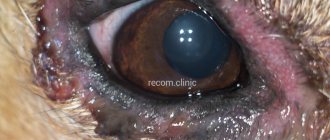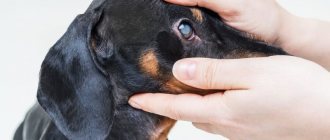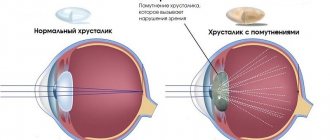Inflammatory processes in the body of animals are a common phenomenon diagnosed in veterinary practice. Inflammation in the area of the prepuce and head of the penis in a pet is called balanoposthitis. The pathology is often diagnosed in male dogs that have not undergone castration.
The pathological process can occur in both mild and severe forms, threatening the normal functioning of the body. The cause of the development of balanoposthitis in males is stagnation of seminal fluid and urine in the area of the preputial sac. Activation and increased growth of colonies of pathogenic bacterial microorganisms occurs, provoking inflammation of the mucous membranes.
The provoking factor is an allergic type reaction, a general decrease in the body's defenses. There are no reliable reasons for the development of balanoposthitis.
Causes of balanoposthitis in males
According to veterinarians, in adult male dogs, mild forms of balanoposthitis can appear spontaneously, without causing the animal any particular suffering and without posing a danger to its health and vital functions. The most curious thing is that such an “unexpected” illness has a tendency to heal spontaneously. Often, dog owners do not notice the course of the disease if it goes away after two or three days.
However, there are also more serious factors that provoke the course of balanoposthitis in severe forms. In this case, the dog may even die. The fact is that the infection often spreads from the preputial sac to the testes, which can result not only in complete sterility of the dog, but also in orchitis (inflammation of the testicles), and in the worst case, peritonitis.
Orchitis in dogs: causes
The most common cause of balanoposthitis is pathogenic microflora spreading to the foreskin area. This happens due to microtraumas of the genital organ (scratches, tears in the mucous membrane, insect bites, injuries received by the animal while running or fighting).
A male running through tall, dry or hard grass may well injure his genitals.
The spread of inflammation due to injury is not the only factor causing balanoposthitis. The causes of the disease can also be a narrowing of the foreskin, when the penis is not exposed (phimosis), allergic reactions, tumors, or a foreign object (for example, dirt or an insect) entering the preputial sac or genital organ. Among the provoking causes are also called damage to the mucous membrane by a fungus, viral and bacterial infections, sexually transmitted diseases (during mating).
Another factor contributing to the development of balanoposthitis is sexual heat in males. According to statistics, the disease occurs in almost 95 percent of uncastrated animals.
Depending on the cause of the disease, balanoposthitis can develop almost asymptomatically or in a mild form, or it can rapidly develop into a severe phase, when intervention by a veterinarian is necessary.
A severe form of the disease must be managed by a veterinarian
Table. Forms of balanoposthitis in males
| Form | Symptoms |
| Easy (simple) | Symptoms are scant, the animal practically does not notice the disease, characteristic manifestations include slight discharge from the prepuce, increased attention of the dog to the genital organ |
| Aggravated | A severe inflammatory process that develops throughout the day. Abundant purulent discharge from the prepuce, enlarged lymph nodes in the neck and groin of the animal. Possible increase in body temperature |
| Chronic | If dog owners ignore treatment for acute balanaposthitis, the disease can become chronic. Characterized by a constant flow of discharge from the genitourinary canal, deterioration in the general condition of the animal, loss of weight, appetite, activity |
| Erosive | Purulent erosions appear on the genital organ and mucous membrane of the prepuce, which spontaneously (or due to the licking of the dog) open, turning into bleeding ulcers |
| Ulcerative-purulent | Complicated erosive form - if the disease is neglected, the ulcers on the genital organ will not only not heal on their own, but will also turn into large damaged areas prone to suppuration. This form is considered life-threatening |
| Gangrenous | The most difficult stage, which only an extremely cruel and irresponsible owner can bring an animal to. The gangrenous form of balanoposthitis includes all of the above symptoms. In addition, the dog looks completely sick and refuses any activity (food, walk, affection). At this stage of the disease there is a high risk of losing the animal. |
With balanoposthitis, inflammation begins to emanate from the head of the genital organ and the mucous membrane of the foreskin
Reasons for the development of inflammation
The most common cause of balanoposthitis in dogs is the contamination of the prepuce with pathogenic microorganisms. This can occur against the background of various injuries (scratches and tears). Rarely, however, another factor that predisposes to the development of balanoposthitis is a tumor. Often the development of balanoposthitis in dogs occurs against the background of such an unpleasant disease as phimosis. This is a pathology, with the development of which there is a narrowing and shrinking of the foreskin, as a result of which the head of the penis is unable to return to its original place. Swelling and inflammation develop, the mucous membranes dry out and become a favorable environment for pathogenic microflora.
For some dog breeds, balanoposthitis is congenital and is caused by certain genetic defects. It most often affects German Shepherds and Golden Retrievers. Sometimes the causes of the development of phimosis and, as a consequence, balanoposthitis are swelling in the tissues of the preputial sac. As mentioned above, this occurs due to the contamination of injured areas with pathogenic or opportunistic microorganisms.
How is balanoposthitis diagnosed in dogs?
Despite the fact that every owner is capable of conducting an initial examination and suggesting a disease in a dog, competent treatment is impossible without veterinary prescriptions. In addition, the owner may not have enough basic physical capabilities to fully examine the animal, and may not have the necessary knowledge to determine the extent of the lesion and choose a treatment regimen.
Therefore, when the first signs of balanoposthitis are detected, you need to show your pet to a qualified veterinarian who will assess the dog’s condition. During the appointment, the veterinarian will examine the animal (you may need an otoscope or even an endoscope). If a male dog does not allow inspection and palpation of the genital organ, which may be due to the nature of the dog or due to excessive pain, the examination is carried out under light sedation.
Symptoms of balanoposthitis
The most characteristic sign of the development of balanoposthitis in dogs is the presence of yellow or green purulent discharge that covers the tip of the prepuncial cavity. In 50% of diseases, blood discharge appears from the penis.
For most owners, the first and main reason to immediately contact a veterinarian is the dog’s constant licking of the genitals. Due to regular contact with saliva, the male dog's scrotum is constantly wet. In this way, he will try to reduce the pain that occurs during the development of inflammatory processes. Naturally, with such a disease, male dogs completely lack interest in mating. Even in cases where he has not lost the ability to mate, it is strictly forbidden to allow it, since purulent discharge and pathogenic microflora can lead to the development of the disease in the female.
How to treat balanoposthitis in a dog?
If the veterinarian has identified a mild form of balanoposthitis, the treatment will be local, that is, the therapy will be aimed exclusively at the affected organ. As a rule, at the initial stage of the disease, it is enough to wash the preputial sac with Miramistin or Chlorhexidine, which can be purchased at any human pharmacy. This procedure does not require any special skill from the owner and will not cause pain to the pet.
How to wash a dog's genitals? First of all, you need to warm the rinsing solution to room temperature (in no case higher, so that the animal does not get burned!). Next, use oilcloth, an old sheet or a large towel. The dog is placed on its side so that the tissue is under the pelvic area.
For rinsing, it is more convenient to purchase “Chlorhexidine” in a bottle with a spout
If the dog is complacent about various types of manipulation, the owner will be able to cope with the procedure on his own; if the pet resists, an assistant will be needed. The animal must be placed on its side, with one hind leg retracted to gain access to the genitals.
The prepuce is carefully pulled upward, carefully pouring the solution into the opening of the foreskin. To do this, you can use a large syringe without a needle, or pour the solution directly from the bottle if it is equipped with a long spout. The procedure must be carried out delicately so as not to cause pain to the pet. After the solution is poured into the preputial sac, you need to squeeze the head of the genital organ and at the same time massage the animal’s perineum.
The next step is to release the animal's genitals and allow the solution to flow out. After washing, you can apply an antibacterial healing ointment, for example, Levomekol, to the mucous membrane. Usually, two or three such washings are also required per day, and after a few days there is a significant improvement, and then the dog’s recovery.
Antibacterial ointment "Levomekol"
Video - Washing a male dog's prepuce
Treatment of advanced balanaposthitis in dogs
Unfortunately, not all forms of the disease require such easy, inexpensive and unburdensome treatment for both the owner and the dog. If balanoposthitis has already entered one of the serious stages, then therapy will be carried out by a veterinarian. The animal may need to be taken to a clinic or left in a hospital.
Severe balanoposthitis is treated in a veterinary clinic
In this situation, rinsing (not Chlorhexidine, but veterinary antiseptic solutions will be used) will become only part of a comprehensive treatment. Depending on the overall clinical picture, the animal may require injections of antibiotics or other drugs, possibly a drip. If the underlying cause of the disease is phimosis or neoplasms, surgical intervention may be required.
Also, complex therapy for balanoposthitis may include antiprotozoal drugs, immunomodulators, vitamin supplements, and the like.
Timely therapy will bring great relief to the animal.
Disease prevention
The main condition for preventing the return of the disease and its prevention is constant hygiene of the dog’s genital organs. To do this, you need to make sure that the dog does not rummage in the dirty soil. If this could not be prevented, after completing the walk, be sure to wash your pet’s foreskin with a disinfectant solution (1-3% hydrogen peroxide solution). Wash your dog regularly using special shampoos that will gently and gently remove all inflammatory processes on the surface of the body.
Do not allow male dogs to mate with infected females who can transmit sexually transmitted infections. Periodically take your pet for a preventive examination to the veterinarian (once a quarter). Be sure to ensure that the animal’s diet is varied and contains all the nutrients, which will help maintain the dog’s immune system at the highest level.
It should also be remembered that an infected dog, especially if it lives under the same roof as its owner, becomes a source of infection for humans and small children. Therefore, keeping your pet in good healthy condition is a guarantee that it will not become a carrier of pathogens that can be transmitted from animals to humans.
Currently reading:
- How to properly draw up a contract for breeding dogs
- Men's health with genital discharge in dogs
- Seven Signs and Remedies for Getting Rid of Fleas in Dogs
- Thyroid dysfunction in dogs (hypothyroidism)
Prevention of balanoposthitis in dogs
Balanoposthitis is an insidious disease that has a tendency to recur. Therefore, the owner must be attentive to the health of the pet, and, knowing about a possible problem, regularly examine the genital organ in order to timely identify the symptoms of the disease. As a preventative measure, a male dog can have his preputial sac washed a couple of times a week using the method described above. In this situation, the dog does not need to be laid on its side - the procedure can be carried out in the bathroom, while washing the animal, or even place the dog over any convenient container.
Dogs that do not have a pedigree (do not carry breeding value) with recurrent balanoposthitis are recommended to be neutered
In general, the above is enough to prevent the disease. Hygiene, attention to the general condition of the dog and a visit to the veterinarian at the first unpleasant symptoms will allow the owner not to worry about the health of his dog.
Diagnosis of balanoposthitis
Diagnosis of balanoposthitis in dogs is very simple. Often it is enough just to visually examine the male dog for the presence of inflammation of the tissues of the foreskin. It is very important to determine what exactly caused the development of the disease: pathogenic microorganisms or the presence of a foreign object in the foreskin. In addition, a study should be conducted to exclude the possibility of developing a tumor disease, because the treatment will be radically different.
In advanced cases, examination may require local anesthesia or general anesthesia, since the dog simply will not allow examination of the affected areas due to severe pain reactions. During the examination, the veterinarian will need to take all the necessary tests, with the most important being a wash and a smear. The samples taken will be sown on a nutrient medium. This will make it possible to quickly and very accurately determine the causative agent of the inflammatory process.
Forbidden topic: 1100 years of veneration of the Prepuce of Christ
The cat loses sex drive. During a clinical examination, veterinary specialists note the appearance of a greenish-yellow coating of purulent exudate on the affected tissues; in the follicular form of the disease, the veterinary specialist can palpate small dense nodules.
The diagnosis of balanoposthitis is made by a veterinary specialist at the clinic based on a clinical examination of the sick cat. At the same time, the specialist sends the exudate to the veterinary laboratory to determine the type of pathogen and at the same time for subtitration of antibiotics.
Treatment. Treatment of inflammation of the prepuce should be aimed at the cause that led to inflammation (infectious disease, phimosis, paraphimosis, orchitis, tumor, etc.). In mild cases of the disease, treatment should be aimed at maintaining ideal cleanliness of the head of the penis and its preputial sac. The prepuce area is washed daily with weak solutions of antiseptics (potassium permanganate, furatsilin, etc.).
Pustules in the prepuce cavity are treated with a 0.5% lapis solution, and the ulcers themselves are cauterized with a lapis pencil.
In the case where purulent discharge is present outside the pustules, a powdered broad-spectrum antibiotic (tricillin) must be injected into the prepuce cavity.
After washing, an antibacterial ointment (levomikol, mastitis forte, neomycin, tetracycline ointment, etc.) is applied to the inflamed mucous membrane of the prepuce.
Prevention. Prevention of inflammation of the prepuce should first of all consist in compliance by cat owners with existing veterinary and sanitary rules for keeping cats.
- Avoid mating with cats that have not been veterinarily tested.
- In order to maintain a high level of immunity, ensure complete, balanced feeding of your cat.
To prevent infectious diseases common in the region of residence, timely vaccination is carried out (preparation of pets for vaccination and types of vaccination).
Tags: Cats
" Back
What is meant by the terms phimosis and paraphimosis? In the first case, it is difficult for the dog to remove the penis from the prepuce, and in the second, everything is exactly the opposite: the head is not covered by the prepuce and is constantly exposed. It can be noted that in both cases the narrowing of the foreskin is to blame.
Paraphimosis is considered more dangerous, since in this condition the skin of the foreskin compresses the head of the penis, impeding normal blood circulation, and this, in turn, can lead to gangrene. Unfortunately, paraphimosis is more common in animals. It usually occurs as a result of a sharp interruption of coitus, various types of injuries, long hair getting into the prepuce, pathological formations and paralysis.
As for phimosis, it occurs due to cicatricial narrowing of the preputial opening, which occurs due to injury or inflammatory processes caused by various types of infections. In general, the narrowing of the foreskin has both a congenital and acquired nature.
Treatment by an experienced veterinarian
After contacting a specialist, first of all, a study will be conducted to find the cause of the disease. It is very important to find and remove all adhesions, tumors and scars that could lead to the development of phimosis and balanoposthitis in the dog. As in the case of the mild form, the dog will undergo daily rinsing of the preputial sac, but high-concentration solutions will be used, which are more effective. If the condition begins to worsen, treatment of balanoposthitis in the dog with antibiotics should be started.









